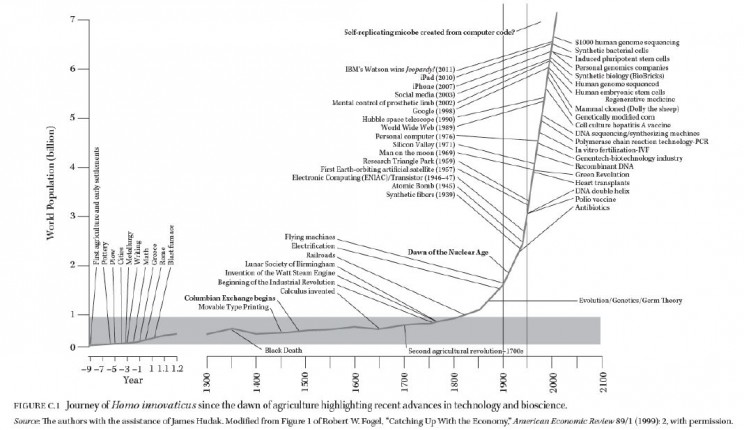By William Hoffman
In pondering how rapidly animal, plant, microbial, viral, and human genetic and regulatory sequences travel around the world over wireless and fiber optic networks, I’m transported back to the sci-fi movie The Fly I watched as a boy. Released in 1958, the film was based on a story George Langelaan published in Playboy. In it, an experiment has gone awry: a matter transporter device called the disintegrator-integrator manages to hybridize the scientist who built it with a housefly. The fly sneaks into the action while the scientist is trying to dematerialize and transport himself from one chamber to another nearby. Two creatures result: a man with the head and left arm of a fly — the head retaining the scientist’s mental faculties — and a fly with a man’s miniature head and left arm.
Hybrid life forms are nothing new in biology. When neuroscientists outfitted laboratory mice with human brain cells, it prompted fears of “nightmare scenarios in which a human mind might be trapped in an animal head,” nightmare scenarios like that of The Fly. Leo Furcht and I noted the ethical concerns surrounding experiments that fused human embryonic cells with rabbit eggs, and human DNA with cow eggs, in The Stem Cell Dilemma. Ananda Chakrabarty, whose name is associated with the 1980 US Supreme Court decision ruling that genetically modified organisms can be patented, raised the question “What is human? This is not a question of the moral dilemma to define a human but is a legal requirement as to how much (human) material a chimpanzee must have before it is declared a part human….”
Hermann Muller employed radioactivity to induce point mutations in the fruit fly Drosophila, sometimes with bizarre results, though there is no evidence (of which I am aware) that George Langelaan was influenced by such experiments in conceiving his story. The technologies that captured Langelaan’s imagination had more to do with communications and information. Communications and culture run the show in his story: the telephone, a constant annoyance that drives the scientist to search for an escape; the typewriter, which he turns to when his voice is altered by the failed experiment; and above all a metamorphic miscommunication made possible by a crude teleporter and a fly. Science and culture scholar Bruce Clarke sees Langelaan’s story and the film as an allegory of modern media.
Another allegory of modern media was the 1960s TV series Star Trek. Gene Roddenberry, its creator, had not read or viewed The Fly when he initially conceived of the “beam me up, Scotty” transporter that Star Trek made famous. Quantum physics tells us it’s not quite that simple to convert a person or object into energy, beam the energy to a target, and then reconvert it into matter. But physicist and author Michio Kaku has predicted that a teleportation device similar to that in Star Trek would be invented by the early 22nd century. (Roddenberry’s fictional device was invented in the early 22nd century by Dr. Emory Erickson.)

The “transporter” on the Starship Enterprise. Photo by Konrad Summers. CC BY-SA 2.0 via Wikimedia Commons.
J. Craig Venter, who led teams that sequenced the genomes of both the fly (Drosophila) and Homo sapiens, described a “biological teleporter” in Life at the Speed of Light. What he and his research team created is manifestly not a matter disintegrator-integrator but a biological code conversion system. The machine, called a digital biological converter, transforms digital-biological information transmitted in electromagnetic waves into proteins, viruses, and even single microbial cells. Unlike the teleporting machines Langelaal and Roddenbery imagined, Venter’s is based on what is actually known about biology, physics, chemistry, materials science, and informatics. Venter’s converter incorporates a variety of technologies including nucleotide synthesis and 3D bioprinting. Though enveloped in myth, the biological teleporter/converter “is not a myth,” says Venter, whose project was funded by DARPA’s “Living Foundries” program. It is already being used to develop and produce vaccines over great distances, and in short order.
On the subject of great distances, Venter wants to use his system to detect life on Mars and bring it to earth. “Although the idea conjures up ‘Star Trek,’ the analogy is not exact,” the New York Times reported. “The transporter on that program actually moves Captain Kirk from one location to another. Dr. Venter’s machine would merely create a copy of an organism from a distant location — more like a biological fax machine.”

The technology timeline above shows the accelerating growth of biological technologies and their convergence with other technologies. Unlike Michio Kaku we do not speculate about human teleportation. We suggest that a self-replicating microbe created entirely from computer code may make its debut in the not-too-distant future. Teleporting it to Mars should be eminently feasible with existing technology. It would be a modest step until the day when mechanisms for our own disintegration and distant reintegration become available, mechanisms equipped with regulatory safeguards to protect us against complications posed by house pests.
William Hoffman has been a writer and editor in the University of Minnesota Medical School for more than three decades. He is the co-author of The Biologist’s Imagination: Innovation in the Biosciences with Leo T. Furcht. He has worked closely with faculty in genetics and bioengineering and with the medical technology and bioscience industries. He has also coauthored books and articles on genetics, stem cell research, and heart disease.
Subscribe to the OUPblog via email or RSS.
Subscribe to only science and medicine articles on the OUPblog via email or RSS.
The post Bioscience, flies, and the future of teleportation appeared first on OUPblog.


